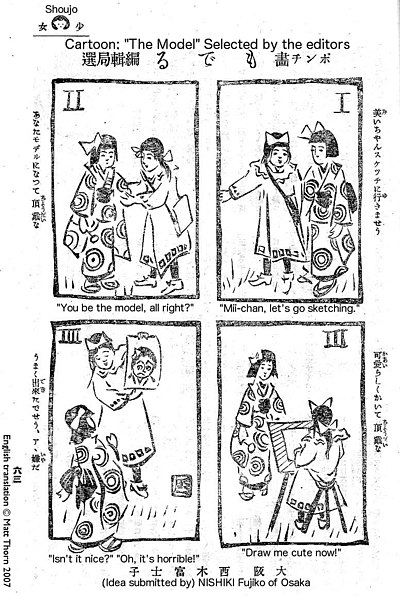
Henohenomoheji (Japanese: へのへのもへじ HEH-noh-HEH-noh-moh-HEH-jee) or hehenonomoheji (へへののもへじ) is a face known to be drawn by Japanese schoolchildren using hiragana characters.[1] It became a popular drawing during the Edo period.[2]
Composition
[edit]The word breaks down into seven hiragana characters: he (へ), no (の), he (へ), no (の), mo (も), he (へ), and ji (じ). The first two he are the eyebrows, the two no are the eyes, the mo is a nose, and the last he is the mouth. The outline of the face is made by the character ji, its two short strokes (dakuten) forming the ear or cheek.
Henohenomoheji is often used to symbolize a nondescript or generic human face, such as the faces of kakashi (scarecrows)[1] and teru teru bōzu. The characters are often sung as they are drawn, making the henohenomoheji an ekaki uta (絵描き歌, drawing song).[2]
Gallery
[edit]-
As a graffito
-
On a teru teru bōzu
-
On a scarecrow
-
An early example as a detail on a netsuke from the 19th century
See also
[edit]References
[edit]- ^ a b "Let's Learn Hiragana with Japanese Culture: Henohenomoheji". Japanese.about.com. Archived from the original on 2014-08-28. Retrieved 2009-08-11.
- ^ a b Natsue, Washizu (1997). わらべうたとナーサリー・ライム (in Japanese). Banseisha. p. 28. ISBN 9784891882709.
External links
[edit]- Henohenomoheji variations at the Wayback Machine (archived May 6, 2015) (in Japanese)





Well, that’s interesting to know that Psilotum nudum are known as whisk ferns. Psilotum nudum is the commoner species of the two. While the P. flaccidum is a rare species and is found in the tropical islands. Both the species are usually epiphytic in habit and grow upon tree ferns. These species may also be terrestrial and grow in humus or in the crevices of the rocks.
View the detailed Guide of Psilotum nudum: Detailed Study Of Psilotum Nudum (Whisk Fern), Classification, Anatomy, Reproduction